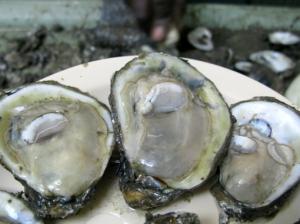The Struggling Oyster Industry in Vietnam

Despite the moves to push for phenomenal growth in the country’s oyster industry, there is a seen major decline in the rate of production in Nam Dinh province, the known largest supplier of oyster in Vietnam. The previous years showed promising figures where in 2004, the province's oyster output peaked at about 30,000 tons. Vietnam's government-owned oyster hatchery on Cat Ba Island recently tied up with an Australian Agricultural team to help take off the struggling industry.
But last year, Nam Dinh’s output only reached 20,000 tons. Being a coastal region, the area is most suitable for mariculture development. Nam Dinh has more than 1,500ha of tidal flats in Giao Thuy and Nghia Hung districts. In Giao Xuan Commune in Giao Thuy, there are more than 100 oyster breeding households with 300ha of farming land. But local farmers had never used all of the land because many of these areas lack young oysters. Annual demand for young oysters is around 1 billion. However, in 2009 the province produced 10 tons, and exploited 100 tons more.
With that, local farmers have had to buy young oysters from neighboring provinces and the practice have continued for 3 consecutive years now. The authorities in charge for overseeing mollusk farmers admit that the locals indeed lack proper knowledge and technology suitable for maximum breeding potential. Apart from the uncontrolled approach of oyster breeding in Nam Dinh, the province also lack an oyster processing factory. The limited technology prevents them from utilizing the asexual reproduction method to increase the number of young oysters.
The output is now predicted to continue to decrease in the coming years. Local farmers need support from ministries and relevant bodies to have access to more advanced technology. Nguyen Van Cuu, chairman of the Giao Thuy Association of Mollusc Farmers, admits the need to acquire Spain's technology – known as the most modern oyster asexual reproduction technology in the world at present.
The struggling industry could now barely meet the demands in the local domestic market. If proper measures are taken, and the province can begin building up oyster breeding areas well as a processing factory, its oyster production will find a large market with high potential. At present, mollusk farmers manage the farming lands by themselves. Thus a re-scheming plan to these farming areas along with clear regulations can better stabilize breeding.
Many other options were discussed including setting up a gauging station so local farmers could receive prompt weather alerts, designing specific plans for crops, breeding density, and young oysters' size, suitable for different communes. However, the province also believe that enterprises, whether local or foreign, who can put up an oyster processing factory can make a big difference and even boost it exports. The province is currently welcoming investments in their area.









